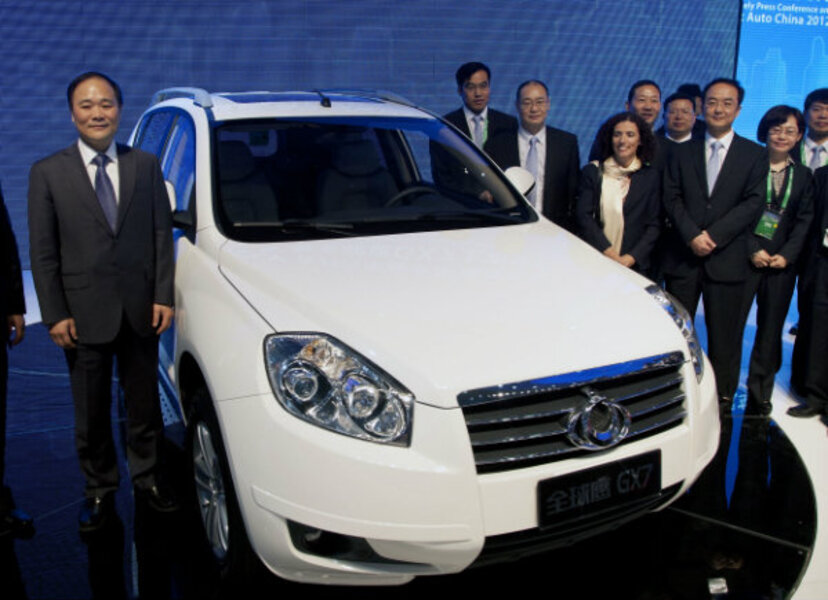The coming rise of Chinese brands
Loading...
| Geneva
As China becomes the world’s manufacturer, talk of bringing back manufacturing jobs from China is ever on American politicians' lips. But are the Chinese as obsessed about keeping those manufacturing jobs as Americans are?
Not really. China’s government and educated class are more long-term strategically inclined. They have their sights set on something much more substantial, much more important for China’s future, something beyond manufacturing – building Chinese-owned global brands.
On my trips to China, I'm always struck by the sheer speed of change there. The Chinese still make mistakes in transforming their economy, but they can cite real achievements, too. Some of my work as a marketing and branding consultant collecting cultural and product stories took me to remote parts of China. Chatting with locals, I was surprised to learn that even they are acutely aware of numbers such as these: that the full retail price of Apple’s iPhone 4s is more than $600, out of which parts cost around $200, but the Chinese manufacturer gets only $8.
Ordinary Chinese watch these numbers keenly and think they’re unfair. They feel their countrymen are justified in demanding higher wages, even if higher wages fuel inflation.
The rising wage pressure is not restricted to manufacturing. A friend, who is a vice president of a multinational company with annual sales of more than $1 billion, told me the cost of hiring software developers in China has risen so much in the past few years, that he will no longer consider China for any new development centers.
That’s the problem of being cheap: Eventually somebody else will become cheaper. The Chinese know this. They understand that to sustain growth and stability, China has to transform itself into “the world’s brand-owner.” That’s where the bigger profit is, where the true economic power lies. They want that for their country.
You can say, “Yeah, dream on. Who in the West wants to buy a Chinese car?” Not many, for now.
Chinese brands’ lack of global appeal came to light for me when I traveled to China to help a Swiss company become the leading gourmet tea brand in Switzerland.
As I collected branding materials and spoke with the plantation owner in Fujian, it dawned on me that his tea was very good, his factory was clean and high-tech. He also sold his own brand of tea in China. Yet internationally he was not able to break out of the “tea manufacturer” role to move up the value chain.
The irony is that tea (especially green tea and oolong tea) is the quintessential Chinese beverage, and China is the only country currently able to produce, in good quality, all six types of tea: green, black, white, yellow, oolong, and pu'erh. But I can’t think of a single Chinese tea company that has made it in the West.
A brand is the gut feeling a person has about a product, service, or company. The Chinese realize for now the developed countries are better at branding, at building product desirability and trust. They know they have a lot to learn and do to overcome China’s “provenance” disadvantage, but they are also encouraged by the success of neighbors such as Japan.
The West initially considered Japanese cars low quality. After decades of trying, Japanese cars managed to gain respect in the compact car category after the mid-'70s. Today, Toyota’s Lexus is a top luxury car brand.
Although 83 percent of people outside China can’t name any of the country’s brands, local companies are developing brand clout at home, according to WPP Group research firm Millward Brown. And they continue to expand their brands, such as home appliances brand Haier, globally.
To gain faster entry to foreign markets, the Chinese also buy foreign brands. Initial attempts had mixed results. When Lenovo bought the IBM PC business and the ThinkPad brand along with it in 2005, it gained sales in China, but the brand subsequently lost desirability in the West, until the recent major marketing/branding efforts reversed the negative trend.
On the other hand, Volvo, sold by Ford to China’s Geely Auto in 2010, is doing very well right off the bat. By developing flashier new models while not betraying its unique selling point of “safety,” Volvo increased 2011 sales in the US by 25 percent from 2010. That’s more than BMW’s 15 percent increase, and better than any of the other top-10 luxury car brands.
With each acquisition, Chinese companies gain a case study about what works and what doesn’t in building and managing brands. Those lessons are valuable for tackling the tougher task of creating homegrown global brands.
The Chinese are formidable competitors. They value education and believe in science and engineering: 8 out of 9 top government officials in China have scientific backgrounds.
So what can the West, particularly the US, do to meet the challenge of keeping and building world-class brands – and face the coming rise of Chinese brands? A passion for innovation and design was the strongest card Americans had in the past, and it will also carry us forward – if we don’t lose it. After all, one can't build a strong brand out of thin air, and at the heart of a great brand is a great product, service, or company with a culture that values creativity.
Keeping manufacturing jobs in America is important, but it’s even more crucial to continue innovating, so that we can build and keep strong brands. If we don’t, the Chinese certainly will.
Arris Han, a Chinese-American marketing and branding consultant, is a former director at Young & Rubicam Brands (now Young & Rubicam Group) in Geneva.





